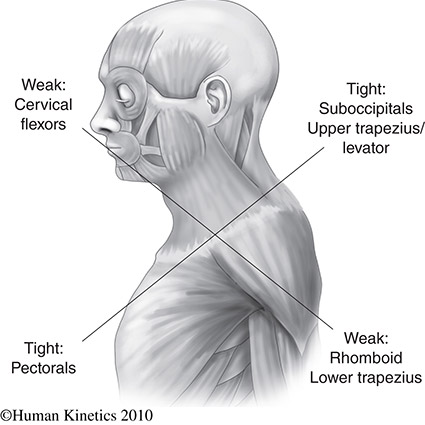
UCS arises from the combination of forward head posture and thoracic kyphosis (slouching of the upper back). UCS, when uncorrected, can lead to chronic neck pain, numbness of the upper extremities, and even difficulty breathing. In years past, it was mostly an occupational hazard, affecting those whose professions required extended forward bending, such as dentists and hairdressers. Today, UCS is proliferating throughout society at large, due to the increased role of computers and cell phones for work and leisure activities.
The origin of the name “Upper Crossed” syndrome is as follows: a line can be drawn between the weakened areas of the body (neck flexors and lower thoracic area) and another line can be drawn between the overly tight areas (chest and upper back muscles), and together these lines form an X shape.
Forward Head Posture (FHP) can be a symptom of UCS but may also occur as a separate condition, or even lead to the development of UCS. The neck may become a weak link very easily, now that so much business and entertainment is now conducted on cell phones. It is very important to hold your phone level with your eyes to keep your neck as straight as possible.
Common symptoms of UCS include
- Neck and shoulder tightness
- Frequent fidgeting at computer due to discomfort
- Lower back pain
- Achy and/or rounded shoulders
- Forward head slouching
Treatment for UCS
Common treatment for UCS involves opening up the chest muscles and engaging the muscles of the back. Core strengthening exercises will also help your posture, helping you to get out, and stay out, of Upper Crossed condition. Dr. Keeler teaches exercises for these areas to patients at his clinic, and a physical therapist may also guide you on an exercise program suited to your unique needs.
Improving the ergonomics of your workplace and home will be crucial for overcoming this condition, and forms of bodywork like massage and acupuncture may also be extremely helpful to you.
